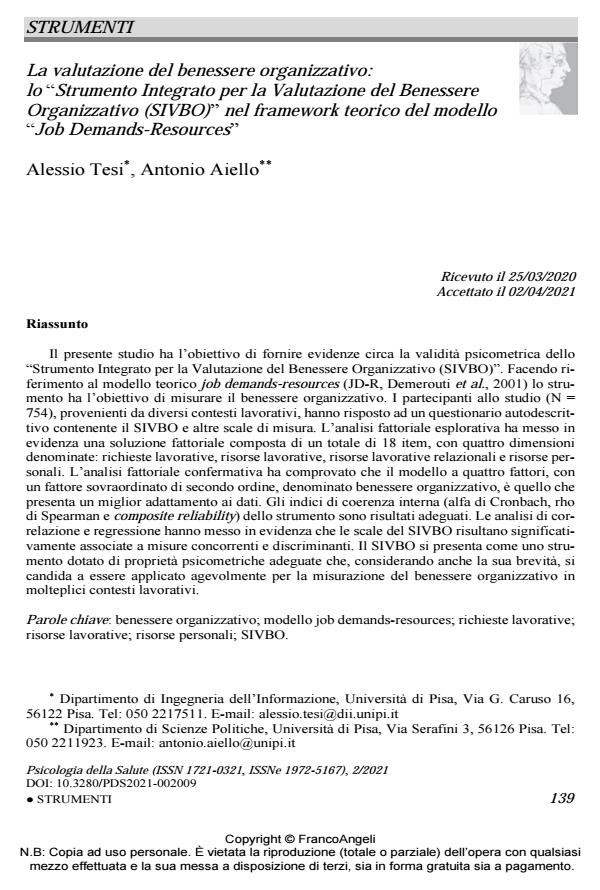The assessment of organizational well-being: the "Integrated tool of organizational well-being (SIVBO)" into the framework of the "Job Demands-Resources" model
Journal title PSICOLOGIA DELLA SALUTE
Author/s Alessio Tesi, Antonio Aiello
Publishing Year 2021 Issue 2021/2
Language Italian Pages 19 P. 139-157 File size 396 KB
DOI 10.3280/PDS2021-002009
DOI is like a bar code for intellectual property: to have more infomation
click here
Below, you can see the article first page
If you want to buy this article in PDF format, you can do it, following the instructions to buy download credits

FrancoAngeli is member of Publishers International Linking Association, Inc (PILA), a not-for-profit association which run the CrossRef service enabling links to and from online scholarly content.
The present study aims at providing evidence about the psychometric proprieties of a new self-report measure named "Integrated tool of organizational well-being (SIVBO)". The SIVBO is based on the job demands-resources model (JD-R, Demerouti et al., 2001) and is aimed at measuring organizational well-being. A total of 754 participants were involved from different organizational contexts. They answered a self-report questionnaire containing the SIVBO and other measures. The exploratory factor analysis highlighted a factorial solution composed by a total of 18 items, underlying four dimensions labeled job demands, job re-sources, relational job resources, and personal resources. The confirmatory factor analysis proved that the four-factor model, with a second-order factor labeled organizational well-being, is the one showing the better fit to the data. The internal consistency indexes (Cronbach’s alpha, Spearman’s rho correlation and composite reliability) of SIVBO were sat-isfactory. Concurrent and discriminant validity were assessed using correlation and regression analyses. The SIVBO is an agile tool with adequate psychometric properties that, due also to its shortness, can be eligible for the measurement of organizational well-being across a variety of work contexts.
Keywords: organizational well-being; job demands-resources model; job demands; job re-sources; personal resources; SIVBO.
- Trait authenticity as an “enzyme” for personal resources and work engagement: A study among teachers within the framework of the job demands-resources model Alessio Tesi, Andrea Baroncelli, Enrica Ciucci, Carolina Facci, Antonio Aiello, in European Review of Applied Psychology 101012/2024 pp.101012
DOI: 10.1016/j.erap.2024.101012
Alessio Tesi, Antonio Aiello, La valutazione del benessere organizzativo: lo "Strumento Integrato per la Valutazione del Benessere Organizzativo (SIVBO)" nel framework teorico del modello "Job Demands-Resources" in "PSICOLOGIA DELLA SALUTE" 2/2021, pp 139-157, DOI: 10.3280/PDS2021-002009